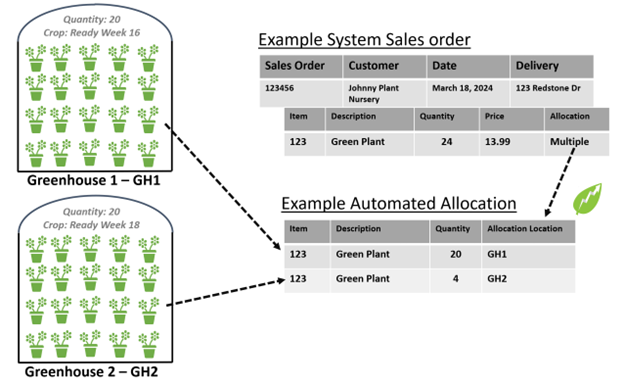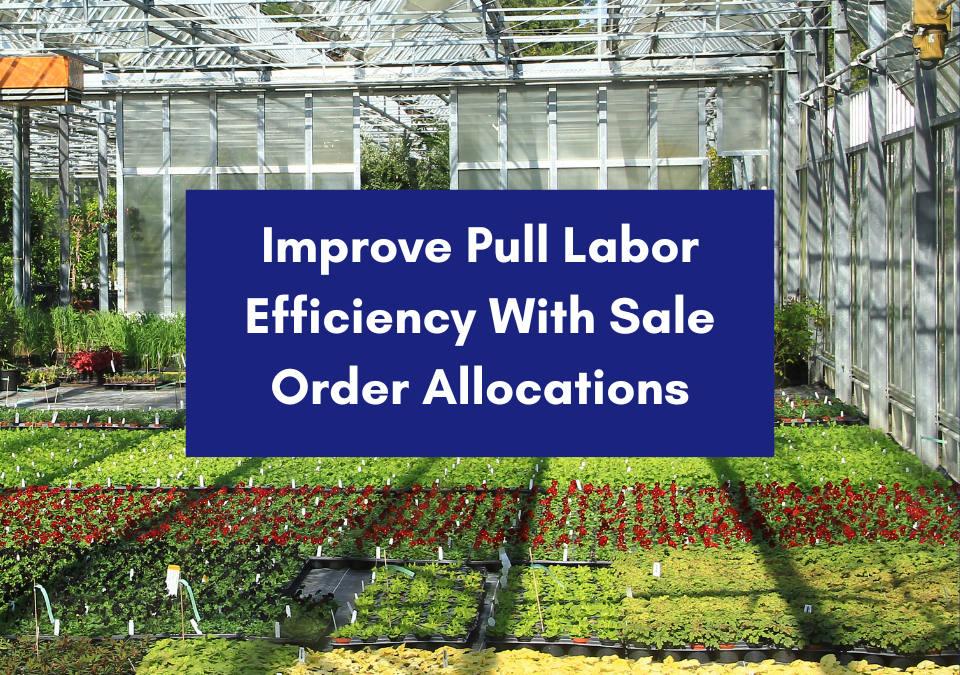
5 Key Elements Of Grower Production Planning
October 23, 2023
Is It Time for Data Analysis In Your Greenhouse or Nursery?
November 1, 2023The sales orders have been entered.
The inventory is in place and ready.
Now what?
Well now it’s time for the classic grower game called ‘find the plants’!
The grower game of ‘find the plants’ is a hybrid of the classic children’s games of ‘hide and seek’ and ‘musical chairs’, where plants hide from you and just when you think you know where they are they can move.
Without appropriate records and processes order pulls can become a giant game of ‘find the plants’ where employees wander around, wasting precious time and dollars, trying to find items to fulfill an order.
‘Find the plants’ is neither fun nor efficient.
Sales Order Pulls Enhanced With Allocations
For growers, the order pull or pick is a labor intensive process which is crucial to order fulfilment and customer satisfaction. It is one of the crucial steps to turn an order into cash.
Order picks are the mechanism that facilitate product selection and shipment.
How do you mitigate ‘find the plants’?
Growers can mitigate ‘find the plants’ by using software systems and employee processes that facilitate having good inventory records coupled with effective sales order allocation processes.
What Are Sales Order Allocations?
An allocation is the internal reservation of inventory for a particular sales order.
For growers that track inventory in locations (Greenhouse, Field etc.) allocation records allow them to know how much product is committed to orders versus available for new sales opportunities at each location they track. Allocations also communicate where to get the product from when its time to pull an order, reducing the chances of playing ‘find the plants’.

Automated Allocations vs Manual Allocations
Deciding where to pull product from to fulfill a particular sales order is a challenge.
There are several methods that can be used. Sales personnel can go look at the crops and decide manually. Many growers pull the ‘oldest product’ first if it meets the necessary quality specifications. Others pull in greenhouse or field order.
There are also ways to encode priority to support automated allocation. For example, locations can have priorities; the crops can have ready dates or priorities; there can be other ways as well to decide what plants to pull first.
A location-crop priority scheme guides automated allocation.
For grower software systems that support it, automated allocations can be a real time saver for your sales and inventory management staff.
Automated allocation algorithms leverage internally defined rules, such as those listed above, and allocate sales order line items to available locations with product.
For example, if you have crop ready dates and set auto allocation to allocate based on ready date, the system will use up the oldest ready crops first, building allocation quantities based on oldest ready date first.
Of course, manual allocations are just that, where a sales or inventory manager explicitly tells the system where to pull the order line / quantity from.
Order Line Allocations Across Multiple Locations
There are times when the order line quantity is more than the quantity of plants that exist in one location of a given product. In these cases, the system should handle, with appropriate rules, building multi-location allocation entries so the full quantity requested on the order can be pulled from the requisite locations.

Improving Customer Relations With Allocations
One of the most frustrating customer experiences is being told that a product is available when, in reality it has already sold. This creates awkward customer interactions.
Allocations can help alleviate bad customer experiences.
When a sales order is allocated, good grower software will also update available quantities, removing the newly allocated quantities from the available amount.
In this way, when a customer calls and asks about a particular product being available the sales team are more confident in their answers.
Improving Labor And Order Pulls With Allocations
Growers can optimize pull labor spend by assiduous pull routes and allocation schemes.
By using optimized routing of picks based on location order or priority, or a combination, unnecessary movement time can be reduced, dollars can be saved, and shipping can occur faster.
Further, good grower software can support wave or group picks, where multiple sales order can be picked at the same time. This method further improves efficiency of pick/pull labor dollars.
Allocations On Master Orders Vs Ad Hoc Sales Orders
Some growers use master orders, pre-book or contract orders to grow reserved product for a key customer.
A challenging aspect of managing pre-books is once the inventory is on the ground ‘protecting’ it from other customers who may place ‘urgent’ ad hoc sales orders – sometimes at higher price points. Without proper allocation reservations its easy to sell the pre-book product to the wrong customer. When that happens, you get to have an uncomfortable conversation with your pre-book customers.
Master order or pre-book allocations help growers reserve inventory blocks for those customers who pre-book. Good grower software will allow you to allocate master orders – even before its ready so that any other sales opportunities are informed from an availability standpoint that the particular inventory is already committed.
Why It Matters
Allocations are an inventory management best practice in our industry. An effective sale order allocation process improves employee communication, helps with customer satisfaction, and improves efficiency of the order fulfillment process.
Learn More
Advanced Grower Solutions provides software that helps growers manage many aspects of the complex inventory process. Contact Us to set up a no obligation call with our knowledgeable and experienced staff to find out how GrowPoint can help improve your operation.





